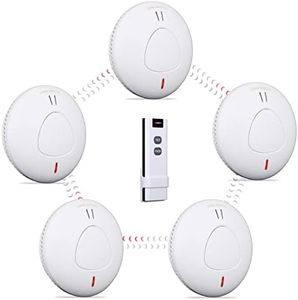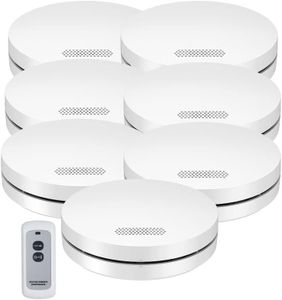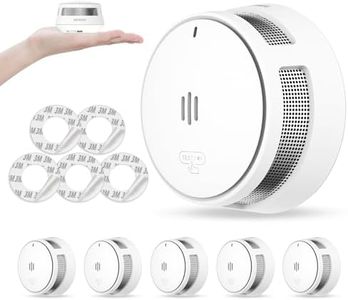We Use CookiesWe use cookies to enhance the security, performance,
functionality and for analytical and promotional activities. By continuing to browse this site you
are agreeing to our privacy policy
7 Best Interconnected Smoke Alarms
From leading brands and best sellers available on the web.By clicking on a link to a third party's website, log data is shared with that third party.
Buying Guide for the Best Interconnected Smoke Alarms
Choosing the right interconnected smoke alarms is important for keeping your home and loved ones safe from fires. These alarms are more advanced than standard single units because when one detects smoke or fire, all connected alarms will sound, giving you and everyone in the building faster warning no matter where the danger is detected. Selecting an interconnected system requires understanding a few key specifications that influence coverage, installation, reliability, and convenience. By matching these features to your home's size, layout, and your personal preferences, you’ll find the best fit for worry-free protection.Interconnection TypeThe interconnection type refers to how the smoke alarms communicate with each other. There are two main types: wired and wireless. Wired systems use physical wires that connect each alarm, often installed during the construction or renovation of a home. Wireless systems use radio signals or similar technology, making them easier to add to existing homes without running wires. If you’re renovating or building, wired may be more reliable and future-proof, but for most homes and renters, wireless offers easy set-up and flexibility. Think about how easy it will be to run wires in your home, or if you might want to take alarms with you when you move.
Power SourceSmoke alarms can be powered by batteries, hardwired into the home’s electrical system, or a combination of both. Battery-operated units are simple to install and don’t need wiring. Hardwired units usually have a battery backup in case of power failure. Hardwired alarms tend to be more reliable, but battery-powered ones are easier to set up, especially in older homes or apartments. When choosing, consider whether you have easy access to your electrical system, and if you’re comfortable changing batteries or want to rely on mains power with backup.
Alarm Sensor TypeThe sensor type affects what kinds of fires the alarm detects best. There are two common sensors: ionization and photoelectric. Ionization sensors usually detect fast, flaming fires faster, while photoelectric sensors are quicker at spotting smoldering, smoky fires. Some alarms combine both sensors to offer broader protection. If you want the most comprehensive safety, look for dual-sensor alarms, but if you know specific risks in your area (like frequent smoky fires), you can match sensor type accordingly.
Coverage RangeCoverage range describes how far apart interconnected alarms can be installed and still communicate with each other. Thorough coverage means placing alarms in sleeping areas, hallways, and every floor. In larger houses, range matters more; wireless systems will have specific maximum ranges for connection—walls and floors can reduce this. Before buying, measure your home and ensure the system’s range will connect every unit reliably. For small apartments this isn’t a concern, but for multi-story or sprawling houses, it’s vital.
Notification OptionsSome interconnected smoke alarms have advanced notification options, such as smartphone alerts, voice announcements, or integration with other smart home systems. Basic models sound an audible alarm only, while smart versions can send notifications when you’re away or tell you exactly where the danger is. If you’re often out or want added convenience, consider alarms with mobile alerts or voice features. Otherwise, a traditional siren may be all you need if you’re usually home and don’t want extra complexity.
Testing and Silencing FeaturesTesting features help ensure your alarms still work, and silencing features let you mute them during false alarms, like when cooking. Some smoke alarms allow easy monthly testing with a simple button, and offer a hush button to quiet the alarm temporarily. If you want low-fuss maintenance and don’t want to climb ladders or fuss with hard-to-reach units, choose alarms with easy-access test/silence functions, especially for those with mobility concerns.







